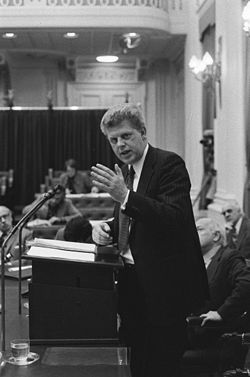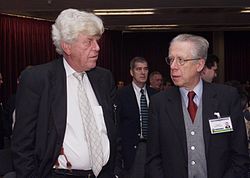- Wim Duisenberg
-
Wim Duisenberg 
1st President of the European Central Bank In office
1 July 1998 – 31 October 2003Vice President Christian Noyer (1998-2002)
Lucas Papademos (2002-2003)Succeeded by Jean-Claude Trichet 2nd President of the European Monetary Institute In office
1 July 1997 – 1 July 1998Preceded by Alexandre Lamfalussy Succeeded by None President of the Central Bank of the Netherlands In office
1 January 1982 – 1 July 1997Preceded by Jelle Zijlstra Succeeded by Nout Wellink Member of the House of Representatives In office
16 January 1978 – 28 June 1978Minister of Finance In office
11 May 1973 – 19 December 1977Prime Minister Joop den Uyl Preceded by Roelof Nelissen Succeeded by Frans Andriessen Personal details Born Willem Frederik Duisenberg
9 July 1935
Heerenveen, NetherlandsDied 31 July 2005 (aged 70)
Faucon, Vaucluse, FranceNationality Dutch Political party Labour Party Spouse(s) Tine Stelling (divorced)
Gretta Duisenberg
(born 1942)Alma mater University of Groningen (PhD)
University of Amsterdam (Dr.h.c.)Occupation Politician
Economist
Banker
Financier
ProfessorReligion None (Atheism) Signature 
Willem Frederik "Wim" Duisenberg (9 July 1935 – 31 July 2005) was a Dutch politician of the Labour Party (PvdA). He was the first President of the European Central Bank from 1 July 1998 until 31 October 2003. He was instrumental in the Introduction of the euro in the European Union in 2002. He was also credited for making numerous improvements for the Economy of the Netherlands. A successful economist and financier he served as Minister of Finance from 11 May 1973 until 19 December 1977, he later served as President of the Central Bank of the Netherlands. [1]
Contents
Biography
Early life
Duisenberg was born in the Frisian town of Heerenveen. He studied at the University of Groningen, where he received a MSc degree in Economics, with majoring in international economic relations. In 1965, he obtained a PhD degree; his thesis was "The Economic Consequences of the Disarmament".[citation needed]
Politics
Duisenberg subsequently worked for the International Monetary Fund in Washington D.C. for years followed by a year as an advisor to the director of the Nederlandsche Bank, the Dutch central bank in Amsterdam. He was then appointed a professor at the University of Amsterdam where he taught macroeconomics.
From 1973 to 1977, Duisenberg was Minister of Finance under Prime Minister Joop den Uyl, Shortly afterwards, he gave up his seat in the Dutch parliament to become vice president of Rabobank, a Dutch bank. Two years later, he was appointed director of the Nederlandsche Bank, serving as its president from 1982 to 1997.
His tenure at the Dutch central bank was marked by caution and reserve. Under his direction, the Dutch guilder was linked to the German Deutsche Mark, and this benefited the Dutch economy, owing to the strength of the German currency. He also followed German central bank's interest rate policies closely, which earned him the nickname "Mr Fifteen Minutes" because he quickly followed any interest rate changes made by the Germans.
First president of the European Central Bank
Owing to the success of his monetary policy, he became well-known in other European countries, and this led to his appointment in 1998 as the first president of the new European Central Bank in Frankfurt, much to the chagrin of France, who wanted a French candidate. A compromise was agreed upon (although publicly denied by all parties) whereby Duisenberg would serve for at least four years, upon which the Frenchman Jean-Claude Trichet, director of the Banque de France, would take over. In 1999, Duisenberg received the Vision for Europe Award in recognition of his efforts toward the unification of Europe.
Duisenberg announced he would retire on 9 July 2003 (his 69th birthday), but he remained in office until Trichet was cleared of charges of fraud in connection with the collapse of the French bank Crédit Lyonnais. Trichet took over presidency of the ECB on 1 November 2003.
Death
Duisenberg died in 2005 at the age of 70 while on vacation at his villa in Faucon near Orange, France. He drowned in his swimming pool after suffering a heart attack. A commemoration service was held on 6 August 2005 in the Amsterdam Concertgebouw. Duisenberg was buried later that day in the Zorgvlied cemetery in Amsterdam. [2] [3]
Quotes
- "Central Bankers are like cream. The more you whip them, the stiffer they get."
- "I hear you, but I do not listen." A response to politicians who loudly pleaded for lowering interest rates to boost the economy.
Decorations
- Order of the Netherlands Lion
- Knight (11 April 1978)
- Commander (17 June 1997)
- Order of Orange-Nassau
- Commander (Unknown)
References
External links
- (Dutch) Dr. W.F. (Wim) Duisenberg (Parlement & Politiek)
Government offices Preceded by
Roelof NelissenMinister of Finance
1973-1977Succeeded by
Frans AndriessenCivic offices Preceded by
Jelle ZijlstraPresident of the Central Bank of the Netherlands
1982-1997Succeeded by
Nout WellinkNon-profit organization positions Preceded by
Alexandre Lamfalussy2nd President of the European Monetary Institute
1997-1998Succeeded by
Merged into the European Central BankPreceded by
First1st President of the European Central Bank
1998-2003Succeeded by
Jean-Claude TrichetCategories:- 1935 births
- 2005 deaths
- Presidents of the European Central Bank
- Presidents of the Central Bank of the Netherlands
- Ministers of Finance of the Netherlands
- Members of the House of Representatives of the Netherlands
- Labour Party (Netherlands) politicians
- Dutch economists
- Dutch bankers
- Dutch academics
- Dutch atheists
- University of Groningen alumni
- University of Amsterdam alumni
- University of Groningen faculty
- University of Amsterdam faculty
- Knights of the Order of the Netherlands Lion
- Commander of the Order of Orange-Nassau
- Commanders of the Order of the Netherlands Lion
- Grand Crosses of the Order of Merit of the Federal Republic of Germany
- People from Heerenveen
- Deaths from myocardial infarction
- Deaths by drowning
Wikimedia Foundation. 2010.


